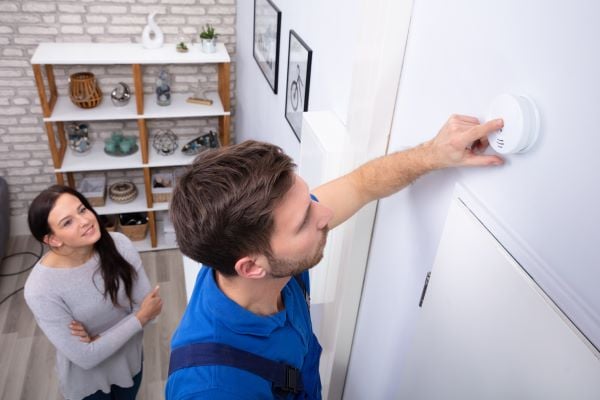
Furnaces, dryer vents, water heaters, fireplaces, generators, lawnmowers, gas-powered stoves, space heaters, cars, charcoal and gas grills –
These and other fuel-burning and gas-powered appliances and tools, which are found in almost every home across the country, produce one of the leading causes of poisoning in America – carbon monoxide.
This is just one reason to install carbon monoxide detectors within the home. But if not properly understood and placed, carbon monoxide detectors may not do much good.
Read on to learn more about what carbon monoxide detectors actually do, why they’re important, and the best locations to install them to ensure your home’s safety.
What is a Carbon Monoxide Detector?
A carbon monoxide detector is not unlike a smoke or fire alarm in that it sounds an alarm when its sensor detects the presence of dangerous levels of carbon monoxide in the air rather than smoke. These detectors are the fastest method to prevent carbon monoxide poisoning, as most will sound the alarm well before symptoms begin.
There are three main types of sensors that carbon monoxide detectors may have:
- Electrochemical sensors, which use an electrode-carrying chemical solution that reacts to changes in electrical currents resulting from contact with carbon monoxide
- Biomimetic sensors, which use a gel that changes color upon absorbing carbon monoxide
- Or Metal oxide semiconductors, which use silica chip circuitry to detect the presence of carbon monoxide
Regardless of the sensor technology used in the detector, when the sensor detects the presence of carbon monoxide, it triggers the alarm. Most will simply sound the alarm, which will notify all present within the home. Still, some types can also be hooked up to the home’s security system and/or to the owner’s smartphone to provide additional notifications.
Do I Really Need a Carbon Monoxide Detector?
The short answer is, yes.
Consider the nature of carbon monoxide: it is a colorless, odorless, tasteless toxic gas that builds up when a carbon fuel – gasoline, wood, natural gas, propane, heating oil, etc. – fails to burn completely.
Carbon monoxide is undetectable to the human senses, yet it is extremely dangerous as it slowly binds to a person’s red blood cells and starves their body of oxygen. It is capable of causing severe permanent damage and even death, earning it the name of “silent killer.” It is, in fact, responsible for over 400 deaths a year and is the 2nd leading cause of US poisoning cases.
Another aspect that makes it so dangerous, besides being undetectable to human senses, is that even the symptoms of carbon monoxide poisoning are easy to miss because they resemble so many other ailments like cold or flu or even high stress and anxiety.
Early symptoms of carbon monoxide poisoning include:
- Headache
- Dizziness
- Shortness of breath
- Fatigue
- Nausea
But if the level of carbon monoxide increases, disorientation and unconsciousness can follow, and symptoms can quickly turn lethal.
Furthermore, even exposure to low doses of carbon monoxide over long periods of time can be just as harmful as brief exposure to extremely high levels. This is why carbon monoxide detectors are set to trigger even at very low doses (50 ppm) of the gas.
Since it is so hard to detect, yet so detrimental, it is easy to see why having carbon monoxide detectors within the home is a good idea, especially if any of the above-listed carbon fuels are ever used within or around your home, as is the case for most Americans.
Where Should I Install a Carbon Monoxide Detector?
Carbon monoxide detectors are most effective when located:
- on every level of the home (including attics and basements)
- near each bedroom or sleeping area
- near doors which lead to any attached garages
The goal is that everyone in the house should be able to hear the alarm if it sounds.
Within regards to specific placement, since carbon monoxide is slightly lighter than air and evenly distributes throughout a space, carbon monoxide detectors are most effective when placed at least five feet high on a wall or a few feet beneath the ceiling.
To ensure the accuracy of a carbon monoxide detector, and to avoid nuisance false alarms, be sure that you place them at least fifteen feet away from vents, windows, fans, and extra humid rooms (such as bathrooms) – all of which could disrupt the accurate reading of carbon monoxide levels – as well as from fuel-burning appliances like gas-powered ovens or stoves, or fireplaces.
Make Your Home & Family Safe
By purchasing, properly installing, and regularly checking on your carbon monoxide detectors, you can easily protect your family from one of the most common causes of poisoning in the country. There’s no need to leave your family’s safety to chance.
If you need additional help protecting your home from fire and other hazards, give Koorsen a call today. They can help you choose the best smoke and carbon monoxide detectors, fire extinguishers, and other fire protection systems for your home to keep you and your family safe.


